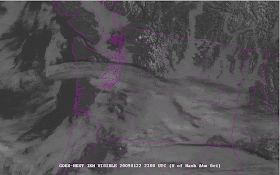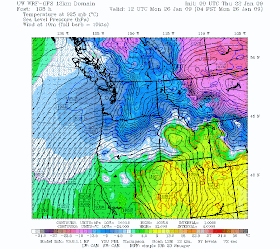
What is the the weather condition that kills and injures more Washington State residents than any other? Floods...no. Windstorms..no. Tornadoes or Thunderstorms. No way. I am pretty sure it is roadway icing...and that threat is very real this week.
Roadway icing is often called "black ice"--but it really isn't really black...it can look dark at some angles and twinkle in others. Roadway icing usually is associated with high pressure situations, with no rain and light winds. There are several ways you can get ice on the road:
1. Frost--skies clear under high pressure and the earth radiates heat to space via infrared radiation. The surface thus cools sufficiently that frost forms on the ground. Frost can be slippery, but it is generally thin.
2. Fog. The big threat. If the ground cools to below freezing and if some nearby fog passes over the ground, it can rapidly and severely ice up.
During the past few days both of these have occurred. Two days ago, I had frost on the street outside my home. Then the fog bank moved in and a 1/4 of ice covered everything...just treacherous.
Keep in mind that on cold, clear or nearly clear nights the temp of the ground can be 3-6 F cooler than the air temperature at 6 ft, where official measurements are made. So if you hear that temps have dropped to 36F or your car thermometer is down to 35...you should be worried, particularly if fog is around.
Once in a while I have testified at legal proceedings about icing accidents, and many of them have occurred under clear nights, with nearby fog, a bend in the road or a turn, and often someone driving to fast for the conditions.
If you want to review a detailed tutorial on this subject, check out:
http://www.atmos.washington.edu/~cliff/Roadway2.htmBy the way, the inversion has strengthened over the central Sound and in some places the fog remained most of day (like at the UW). (see graphic of inversion from the profiler). You can easily get out of the murk by going up (above 600 ft should do it). Air quality has declined as result, so no burning if you don't have to.

Finally, a reminder that I will talk about
Lowland Snowstorms at Third Place Books in Lake Forest Park tomorrow (Wed) at 7PM.




















































